Influence of Soil Temperature on Potential Evaporation over Saturated Surfaces—In Situ Lysimeter Study
Abstract
1. Introduction
- (1)
- What are the differences in potential evaporation (PE) and soil temperature (T) across different fully saturated soil textures?
- (2)
- How do PE estimation methods, with and without considering T, perform relative to observations?
- (3)
- How does T affect PE rates through its influence on surface energy redistribution?
2. Materials and Methods
2.1. Study Site
2.2. Experimental Setup and Field Measurements
2.2.1. Lysimeter Device and Sensors
2.2.2. Sensors and Meteorological Data
2.2.3. Data Quality Assurance and Quality Control (QA/QC) Procedures
2.3. Methodology
2.3.1. Energy Balance Method
2.3.2. The Radiatively Coupled and the Simplified Penman-Monteith Equations
2.3.3. Random Forest Model
3. Results
3.1. Potential Evaporation over Saturated Surfaces
3.2. Soil Temperatures over Saturated Surfaces
3.3. Surface Energy Balance Components
3.3.1. Energy Balance Components in the Surface Energy Balance Equation
- A.
- Net radiation (Rn)
- B.
- Total ground heat flux (G5 + ∆S)
- C.
- Sensible heat flux (H)
3.3.2. Energy Balance Components in Two Variants of the Penman-Monteith Equations
3.4. Model Verification and Comparison
3.4.1. Daily Scale Evaluation
3.4.2. Hourly Scale Evaluation
3.4.3. Contribution of Soil Temperature to Changes in PE
4. Discussion
4.1. Influence of Soil Temperature on Energy Partitioning in Evaporation Process over Saturated Surfaces
4.2. Driving Characteristics of Surface Temperature and Heat Flux on PE Estimation
4.3. Study Scope and Future Perspectives
5. Conclusions
- (1)
- Significant differences in PE and T were observed among saturated fine sand, coarse sand, and gravel based on experiment results. The differences are particularly pronounced during daytime in spring and summer. As for T, gravel exhibited the most pronounced surface temperature variation among the three textures. On a daily basis in August, (Ts–Ta) for gravel was 0.4 °C and 1.2 °C higher than that for coarse sand and fine sand, respectively.
- (2)
- A comparison of the methods revealed strong agreement of PE between the energy balance equation, radiatively coupled PM, and lysimeter measurements at daily and hourly timescales. In contrast, the simplified PM (which simplified the dependence of T on longwave radiation Rn,l and soil heat flux G) performed poorly in capturing PE dynamics, yielding inaccuracies in both the amplitude and phase of diurnal PE cycles, as well as the PE differences among the three saturated textures.
- (3)
- A combined analysis—employing surface energy balance equations and a data-driven Random Forest (RF) model—was conducted to quantify the influence of T on PE. Surface temperature (Ts and T3) and G (determined by ∂T/∂z) were shown to play non-negligible roles in PE estimation, roles that are often simplified or overlooked in sub-daily modeling applications.
Supplementary Materials
Author Contributions
Funding
Data Availability Statement
Acknowledgments
Conflicts of Interest
Abbreviations
| Es | bare soil evaporation [mm] |
| ET | evapotranspiration [mm] |
| ETo | grass reference evapotranspiration [mm] |
| ea | actual vapor pressure [kPa] |
| es | saturated vapor pressure [kPa] |
| G | total ground heat flux [W m−2] |
| G5 | soil heat flux measured by the plate [W m−2] |
| H | sensible heat flux [W m−2] |
| LE | latent heat for evaporation [W m−2] |
| PE | potential evaporation [mm] |
| RH | relative humidity [-] |
| ra | aerodynamic resistance [s m−1] |
| Rn | net radiation [W m−2] |
| Rn,s | net shortwave radiation [W m−2] |
| Rn,l | net longwave radiation [W m−2] |
| Rsd | downwards/incoming shortwave radiations [W m−2] |
| Rld | downwards/incoming longwave radiations [W m−2] |
| Rsu | upwards/outgoing shortwave radiations [W m−2] |
| Rlu | upwards/outgoing longwave radiation [W m−2] |
| Rs | solar radiation [W m−2] |
| Rso | clear sky solar radiation [W m−2] |
| Ri | Richardson number |
| rs | soil/bulk resistance [s m−1] |
| ∆S | heat storage variations between the heat flux plate and the surface [W m−2] |
| SI | sensitivity indices |
| S1 | first order sensitivity indices |
| ST | total sensitivity indices |
| T | soil temperature [°C or K] |
| Ta | air temperature [°C or K] |
| Ts | surface temperature [°C or K] |
| u | wind speed [m s−1] |
| α | albedo for shortwave radiation |
| ε | emissivity of longwave radiation |
| σ | Stefan-Boltzman constant [W m−2 K−4] |
| ψ | stability correction parameter |
| γ | psychrometric constant |
| δ | thermal penetration depth [cm] |
| ∆ | saturation vapor pressure curve slope [kPa·°C−1] |
Appendix A. Surface Energy Balance Equation
Appendix B. Penman-Monteith Equation According to the FAO-56 Standard
References
- Vanderborght, J.; Fetzer, T.; Mosthaf, K.; Smits, K.M.; Helmig, R. Heat and Water Transport in Soils and across the Soil-Atmosphere Interface: 1. Theory and Different Model Concepts. Water Resour. Res. 2017, 53, 1057–1079. [Google Scholar] [CrossRef]
- Coenders-Gerrits, A.M.J.; Van der Ent, R.J.; Bogaard, T.A.; Wang-Erlandsson, L.; Hrachowitz, M.; Savenije, H.H.G. Uncertainties in Transpiration Estimates. Nature 2014, 506, E1–E2. [Google Scholar] [CrossRef]
- Gong, X.; Zhang, H.; Ren, C.; Sun, D.; Yang, J. Optimization Allocation of Irrigation Water Resources Based on Crop Water Requirement under Considering Effective Precipitation and Uncertainty. Agric. Water Manag. 2020, 239, 106264. [Google Scholar] [CrossRef]
- Zhang, Y.; Shen, Y.; Wang, J.; Qi, Y. Estimation of Evaporation of Different Cover Types Using a Stable Isotope Method: Pan, Bare Soil, and Crop Fields in the North China Plain. J. Hydrol. 2022, 613, 128414. [Google Scholar] [CrossRef]
- Rosa, R.D.; Paredes, P.; Rodrigues, G.C.; Alves, I.; Fernando, R.M.; Pereira, L.S.; Allen, R.G. Implementing the Dual Crop Coefficient Approach in Interactive Software. 1. Background and Computational Strategy. Agric. Water Manag. 2012, 103, 8–24. [Google Scholar] [CrossRef]
- Xiang, K.; Li, Y.; Horton, R.; Feng, H. Similarity and Difference of Potential Evapotranspiration and Reference Crop Evapotranspiration—A Review. Agric. Water Manag. 2020, 232, 106043. [Google Scholar] [CrossRef]
- Therrien, R.; McLaren, R.G.; Sudicky, E.A.; Panday, S.M. A Three-Dimensional Numerical Model Describing Fully-Integrated Subsurface and Surface Flow and Solute Transport; University of Waterloo: Waterloo, ON, Canada, 2010; Draft 467p. [Google Scholar]
- Han, Z.; Zhang, H.; Fu, J.; Wang, Z.; Duan, L.; Zhang, W.; Li, Z. Dynamic Assessment of the Impact of Compound Dry-Hot Conditions on Global Terrestrial Water Storage. Remote Sens. Environ. 2024, 315, 114428. [Google Scholar] [CrossRef]
- Li, W.; Brunner, P.; Hendricks Franssen, H.-J.; Li, Z.; Wang, Z.; Zhang, Z.; Wang, W. Potential Evaporation Dynamics over Saturated Bare Soil and an Open Water Surface. J. Hydrol. 2020, 590, 125140. [Google Scholar] [CrossRef]
- Assouline, S.; Narkis, K.; Gherabli, R.; Lefort, P.; Prat, M. Analysis of the Impact of Surface Layer Properties on Evaporation from Porous Systems Using Column Experiments and Modified Definition of Characteristic Length. Water Resour. Res. 2014, 50, 3933–3955. [Google Scholar] [CrossRef]
- Lehmann, P.; Or, D. Effect of Wetness Patchiness on Evaporation Dynamics from Drying Porous Surfaces. Water Resour. Res. 2013, 49, 8250–8262. [Google Scholar] [CrossRef]
- Lehmann, P.; Or, D. Evaporation and Capillary Coupling across Vertical Textural Contrasts in Porous Media. Phys. Rev. E 2009, 80, 046318. [Google Scholar] [CrossRef]
- Or, D.; Lehmann, P. Surface Evaporative Capacitance: How Soil Type and Rainfall Characteristics Affect Global–Scale Surface Evaporation. Water Resour. Res. 2019, 55, 519–539. [Google Scholar] [CrossRef]
- Shahraeeni, E.; Or, D. Pore Scale Mechanisms for Enhanced Vapor Transport through Partially Saturated Porous Media. Water Resour. Res. 2012, 48. [Google Scholar] [CrossRef]
- Brutsaert, W. Evaporation into the Atmosphere: Theory, History and Applications; Springer Science & Business Media: Berlin/Heidelberg, Germany, 2013; Volume 1, ISBN 94-017-1497-5. [Google Scholar]
- Jensen, M.E.; Allen, R.G. (Eds.) Evaporation, Evapotranspiration, and Irrigation Water Requirements, 2nd ed.; American Society of Civil Engineers: Reston, VA, USA, 2016; ISBN 978-0-7844-1405-7. [Google Scholar]
- Penman, H.L. Natural Evaporation from Open Water, Bare Soil and Grass. Proc. R. Soc. Lond. 1948, 193, 120–145. [Google Scholar] [CrossRef]
- Monteith, J.; Unsworth, M. Principles of Environmental Physics, 4th ed.; Elsevier: Amsterdam, The Netherlands, 2013. [Google Scholar] [CrossRef]
- McColl, K.A. Practical and Theoretical Benefits of an Alternative to the Penman-Monteith Evapotranspiration Equation. Water Resour. Res. 2020, 56, e2020WR027106. [Google Scholar] [CrossRef]
- Allen, R.G.; Pereira, L.S.; Raes, D.; Smith, M. Crop Evapotranspiration-Guidelines for Computing Crop Water Requirements-FAO Irrigation and Drainage Paper 56; FAO Rome: Rome, Italy, 1998; Volume 300, p. D05109. [Google Scholar]
- Li, W.; Hendricks Franssen, H.-J.; Brunner, P.; Li, Z.; Wang, Z.; Wang, Y.; Wang, W. The Role of Soil Texture on Diurnal and Seasonal Cycles of Potential Evaporation over Saturated Bare Soils—Lysimeter Studies. J. Hydrol. 2022, 613, 128194. [Google Scholar] [CrossRef]
- Shen, Y.; Li, J.; Wang, W.; Deng, H.; Wang, Z. Data acquisition device for automatic evaporation and precipitation measurement. CN201410042751.X[P] 23 April 2014. [Google Scholar]
- Evett, S.R.; Marek, G.W.; Copeland, K.S.; Colaizzi, P.D. Quality Management for Research Weather Data: USDA-ARS, Bushland, TX. Agrosyst. Geosci. Environ. 2018, 1, 1–18. [Google Scholar] [CrossRef]
- Allen, R.G. ASCE Standardized Reference Evapotranspiration Equation; American Society of Civil Engineers: Reston, VA, USA, 2018; ISBN 978-0-7844-0805-6. [Google Scholar]
- Allen, R.G.; Pereira, L.S.; Howell, T.A.; Jensen, M.E. Evapotranspiration Information Reporting: I. Factors Governing Measurement Accuracy. Agric. Water Manag. 2011, 98, 899–920. [Google Scholar] [CrossRef]
- Evett, S.R.; Schwartz, R.C.; Howell, T.A.; Louis Baumhardt, R.; Copeland, K.S. Can Weighing Lysimeter ET Represent Surrounding Field ET Well Enough to Test Flux Station Measurements of Daily and Sub-Daily ET? Adv. Water Resour. 2012, 50, 79–90. [Google Scholar] [CrossRef]
- Marek, G.W.; Evett, S.R.; Gowda, P.H.; Howell, T.A.; Copeland, K.S.; Baumhardt, R.L. Post-Processing Techniques for Reducing Errors in Weighing Lysimeter Evapotranspiration (ET) Datasets. Trans. ASABE 2014, 57, 499–515. [Google Scholar] [CrossRef]
- Evett, S.R.; Howell, T.A.; Schneider, A.D.; Copeland, K.S.; Dusek, D.A.; Brauer, D.K.; Tolk, J.A.; Marek, G.W.; Marek, T.M.; Gowda, P.H. The Bushland Weighing Lysimeters: A Quarter Century of Crop ET Investigations to Advance Sustainable Irrigation. Trans. ASABE 2016, 59, 163–179. [Google Scholar] [CrossRef]
- An, K.; Wang, W.; Wang, Z.; Zhao, Y.; Yang, Z.; Chen, L.; Zhang, Z.; Duan, L. Estimation of Ground Heat Flux from Soil Temperature over a Bare Soil. Theor. Appl. Climatol. 2017, 129, 913–922. [Google Scholar] [CrossRef]
- Yang, Q.; Zhang, M.; Zhou, J. Ground Surface—Soil Thermal Inversion From In Situ Measurement. JGR Atmos. 2023, 128, e2023JD038502. [Google Scholar] [CrossRef]
- Gavilán, P.; Berengena, J.; Allen, R.G. Measuring versus estimating net radiation and soil heat flux: Impact on Penman–Monteith reference ET estimates in semiarid regions. Agric. Water Manag. 2007, 89, 275–286. [Google Scholar] [CrossRef]
- Fernández, E. Editorial Note on Terms for Crop Evapotranspiration, Water Use Efficiency and Water Productivity. Agric. Water Manag. 2023, 289, 108548. [Google Scholar] [CrossRef]
- Purdy, A.J.; Fisher, J.B.; Goulden, M.L.; Famiglietti, J.S. Ground Heat Flux: An Analytical Review of 6 Models Evaluated at 88 Sites and Globally. J. Geophys. Res. Biogeosci. 2016, 121, 3045–3059. [Google Scholar] [CrossRef]
- Groh, J.; Pütz, T.; Gerke, H.H.; Vanderborght, J.; Vereecken, H. Quantification and Prediction of Nighttime Evapotranspiration for Two Distinct Grassland Ecosystems. Water Resour. Res. 2019, 55, 2961–2975. [Google Scholar] [CrossRef]
- Lim, W.H.; Roderick, M.L.; Hobbins, M.T.; Wong, S.C.; Groeneveld, P.J.; Sun, F.; Farquhar, G.D. The Aerodynamics of Pan Evaporation. Agric. For. Meteorol. 2012, 152, 31–43. [Google Scholar] [CrossRef]
- Liu, S.; Lu, L.; Mao, D.; Jia, L. Evaluating Parameterizations of Aerodynamic Resistance to Heat Transfer Using Field Measurements. Hydrol. Earth Syst. Sci. 2007, 11, 769–783. [Google Scholar] [CrossRef]
- Saito, H.; Šimůnek, J. Effects of Meteorological Models on the Solution of the Surface Energy Balance and Soil Temperature Variations in Bare Soils. J. Hydrol. 2009, 373, 545–561. [Google Scholar] [CrossRef]
- GB/T 50123-1999; Standard for Soil Test Method. Ministry of Housing and Urban-Rural Development: Beijing, China, 2017.
- Lawrence, P.J.; Chase, T.N. Representing a MODIS Consistent Land Surface in the Community Land Model (CLM 3.0): Part 1 Generating MODIS Consistent Land Surface Parameters. J. Geophys. Res. Biogeosci. 2007, 112, 862–880. [Google Scholar] [CrossRef]
- Liu, H.; Wang, B.; Fu, C. Relationships between Surface Albedo, Soil Thermal Parameters and Soil Moisture in the Semi-Arid Area of Tongyu, Northeastern China. Adv. Atmos. Sci. 2008, 25, 757–764. [Google Scholar] [CrossRef]
- Zheng, Z.; Wei, Z.; Wen, Z.; Dong, W.; Li, Z.; Wen, X.; Zhu, X.; Ji, D.; Chen, C.; Yan, D. Inclusion of Solar Elevation Angle in Land Surface Albedo Parameterization over Bare Soil Surface. J. Adv. Model. Earth Syst. 2017, 9, 3069–3081. [Google Scholar] [CrossRef] [PubMed]
- Roxy, M.S.; Sumithranand, V.B.; Renuka, G. Soil Heat Flux and Day Time Surface Energy Balance Closure at Astronomical Observatory, Thiruvananthapuram, South Kerala. J. Earth Syst. Sci. 2014, 123, 741–750. [Google Scholar] [CrossRef]
- Cellier, P.; Richard, G.; Robin, P. Partition of Sensible Heat Fluxes into Bare Soil and the Atmosphere. Agric. For. Meteorol. 1996, 82, 245–265. [Google Scholar] [CrossRef]
- Stewart, J.B.; Kustas, W.P.; Humes, K.S.; Nichols, W.D.; Moran, M.S.; de Bruin, H.A. Sensible Heat Flux-Radiometric Surface Temperature Relationship for Eight Semiarid Areas. J. Appl. Meteorol. 1994, 33, 1110–1117. [Google Scholar] [CrossRef]
- Zotarelli, L.; Dukes, M.D.; Romero, C.C.; Migliaccio, K.W.; Morgan, K.T. Step by Step Calculation of the Penman-Monteith Evapotranspiration (FAO-56 Method); Institute of Food and Agricultural Sciences, University of Florida: Gainesville, FL, USA, 2010. [Google Scholar]
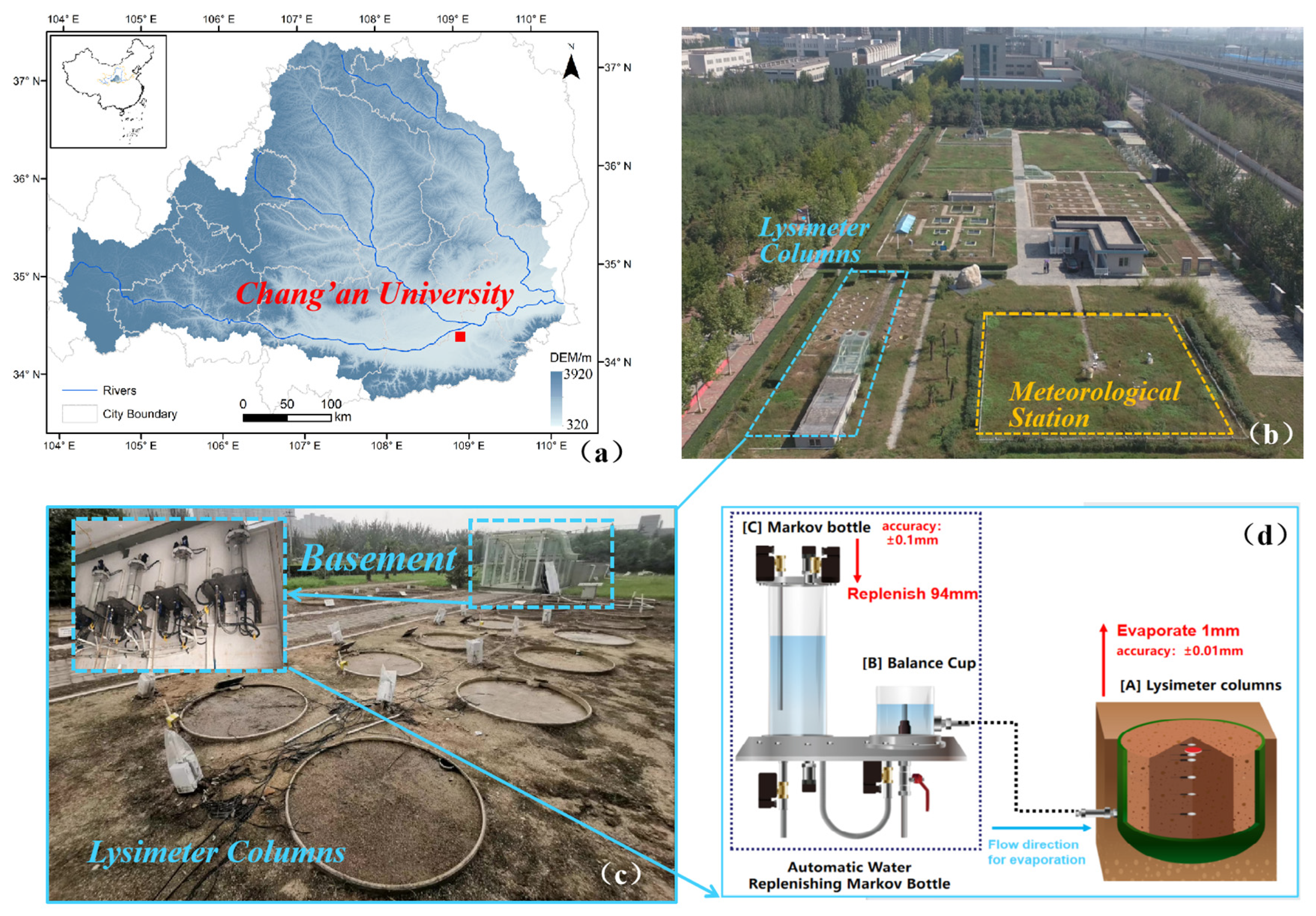
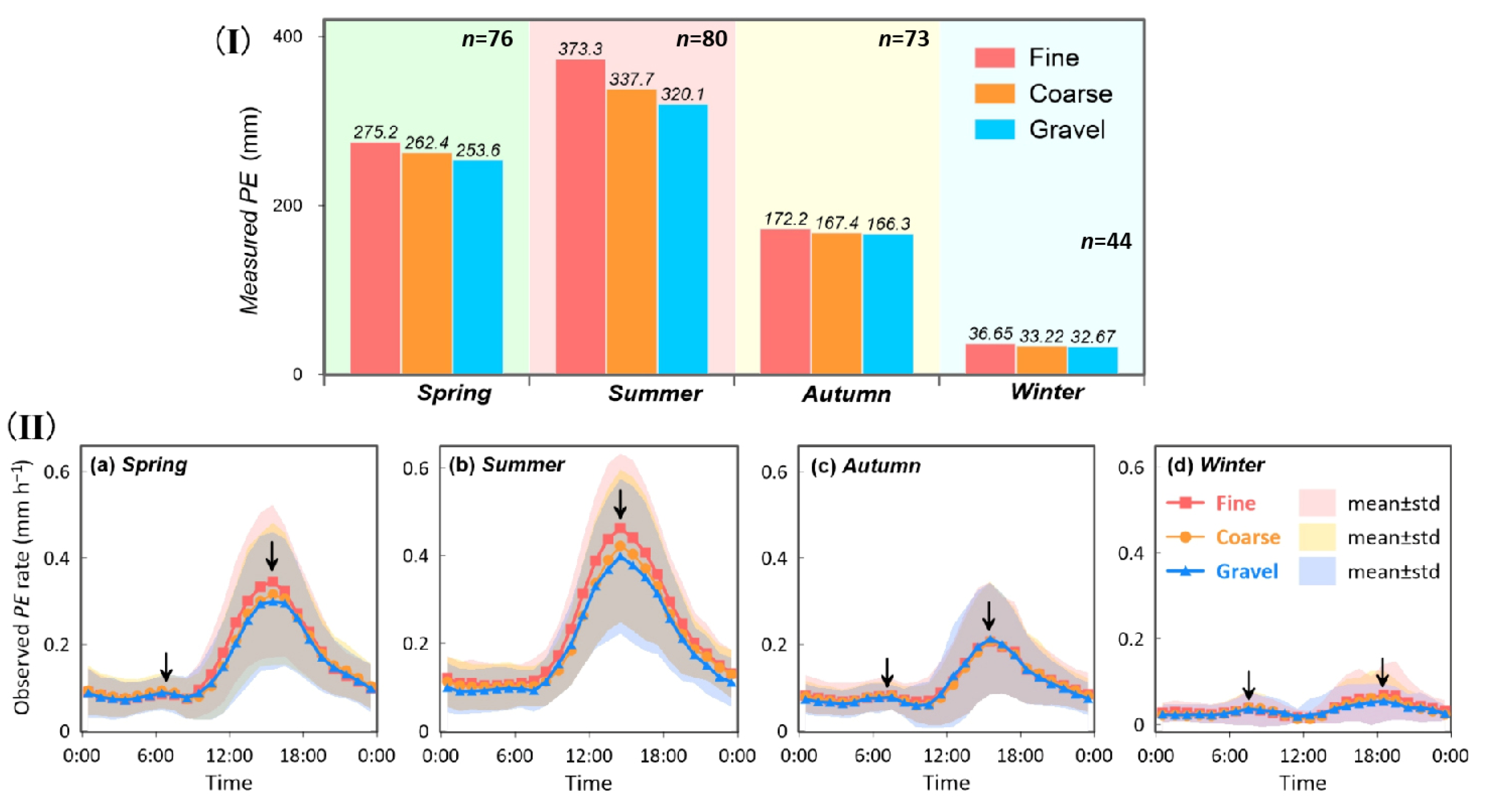
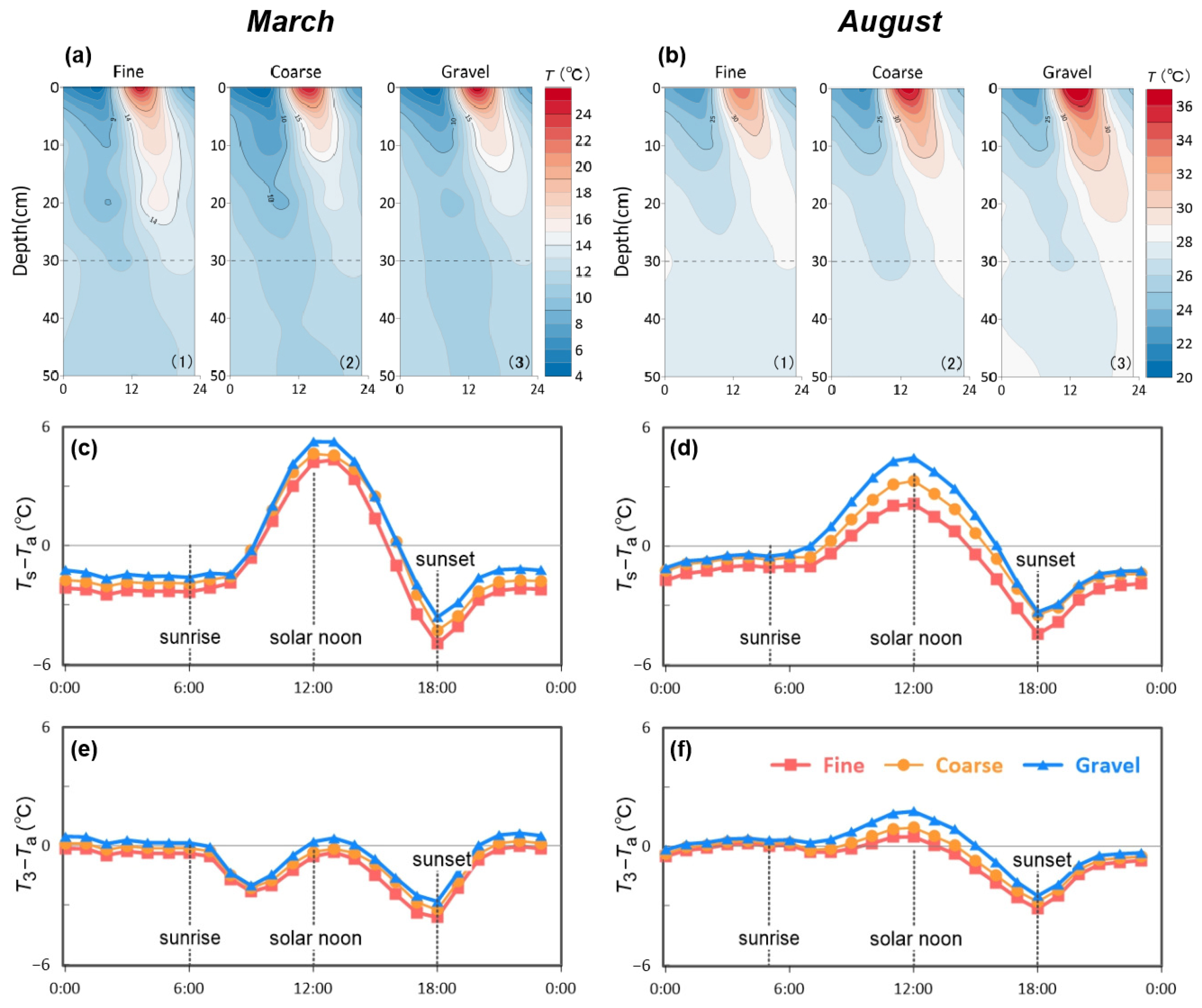
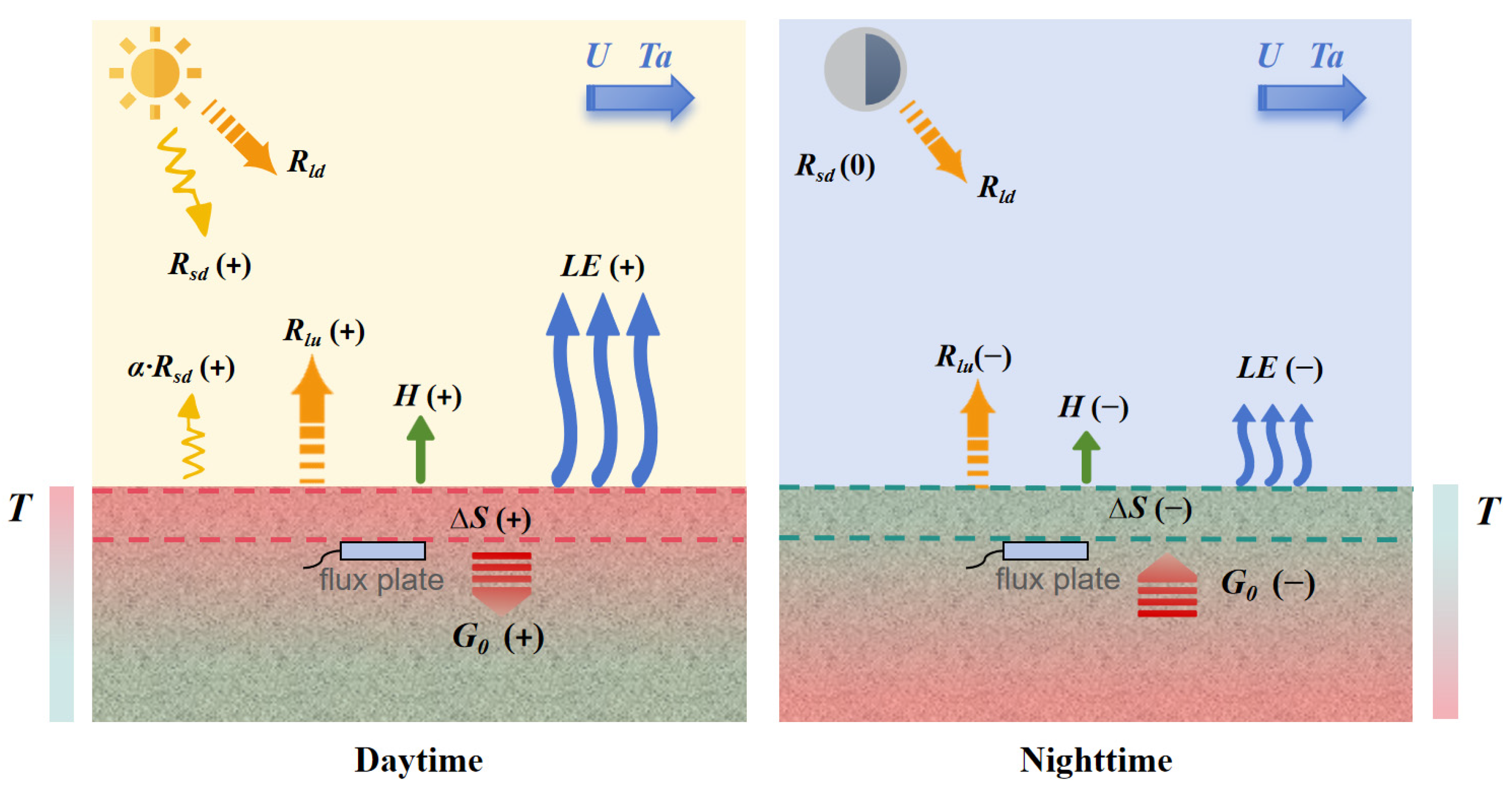
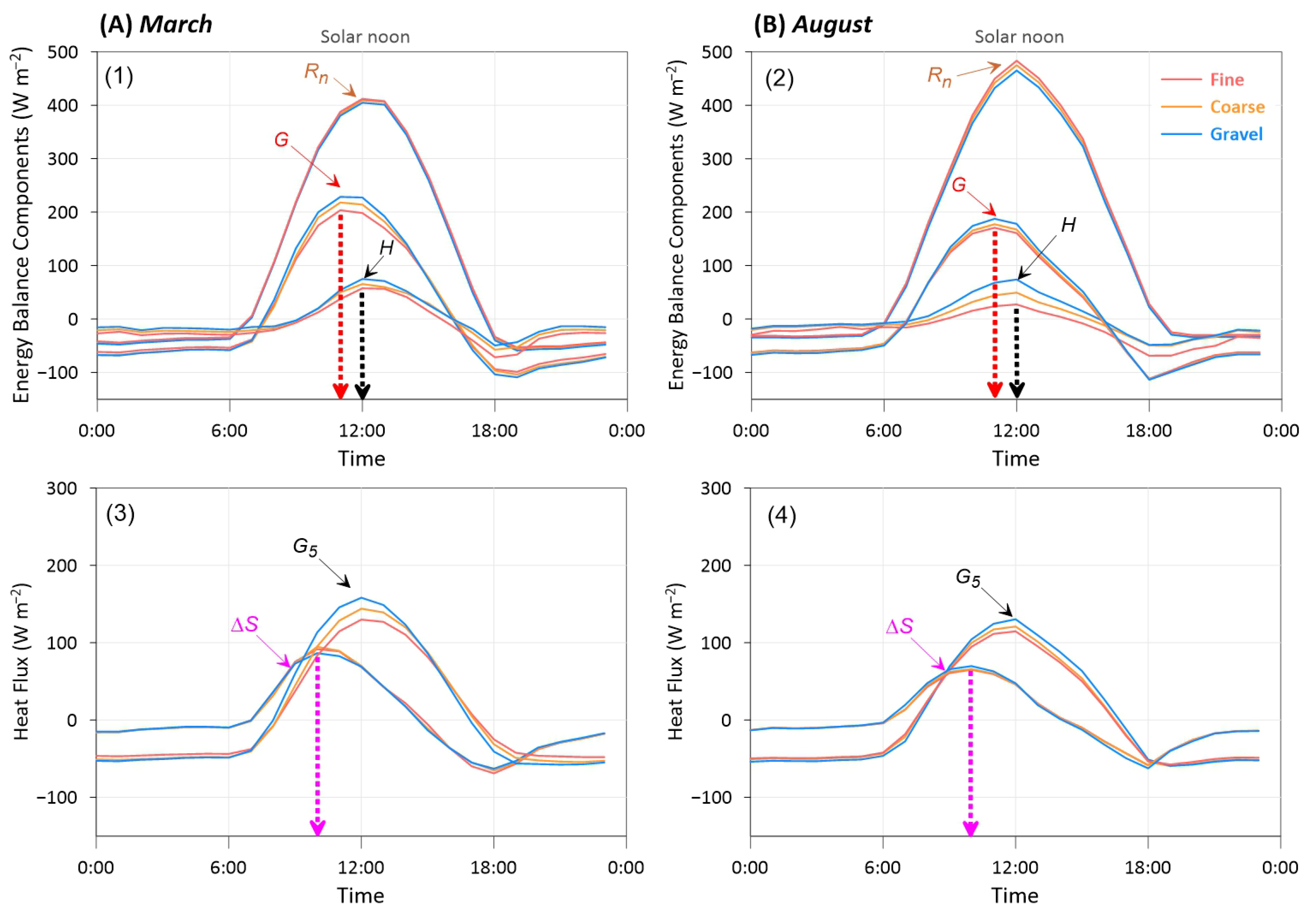
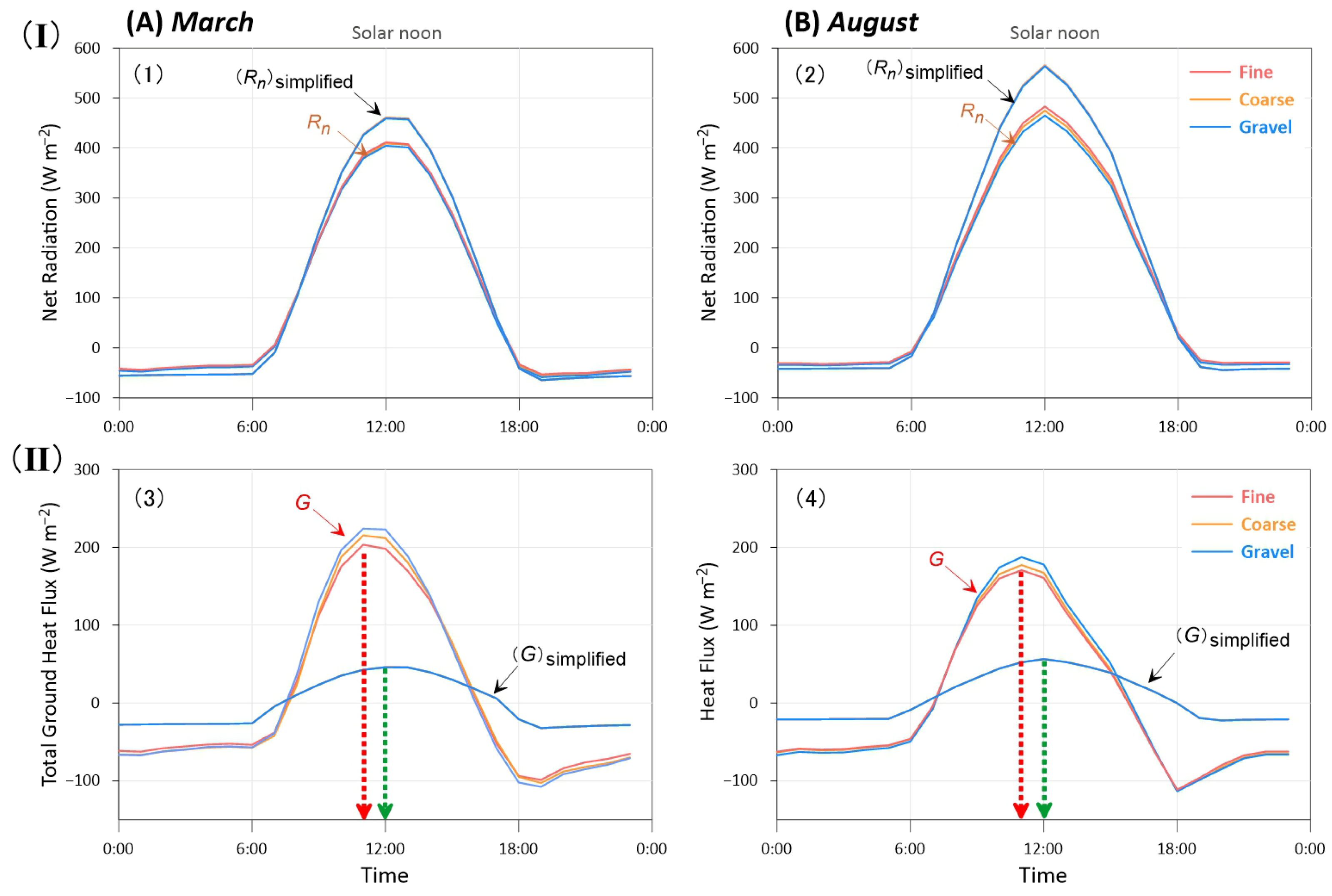
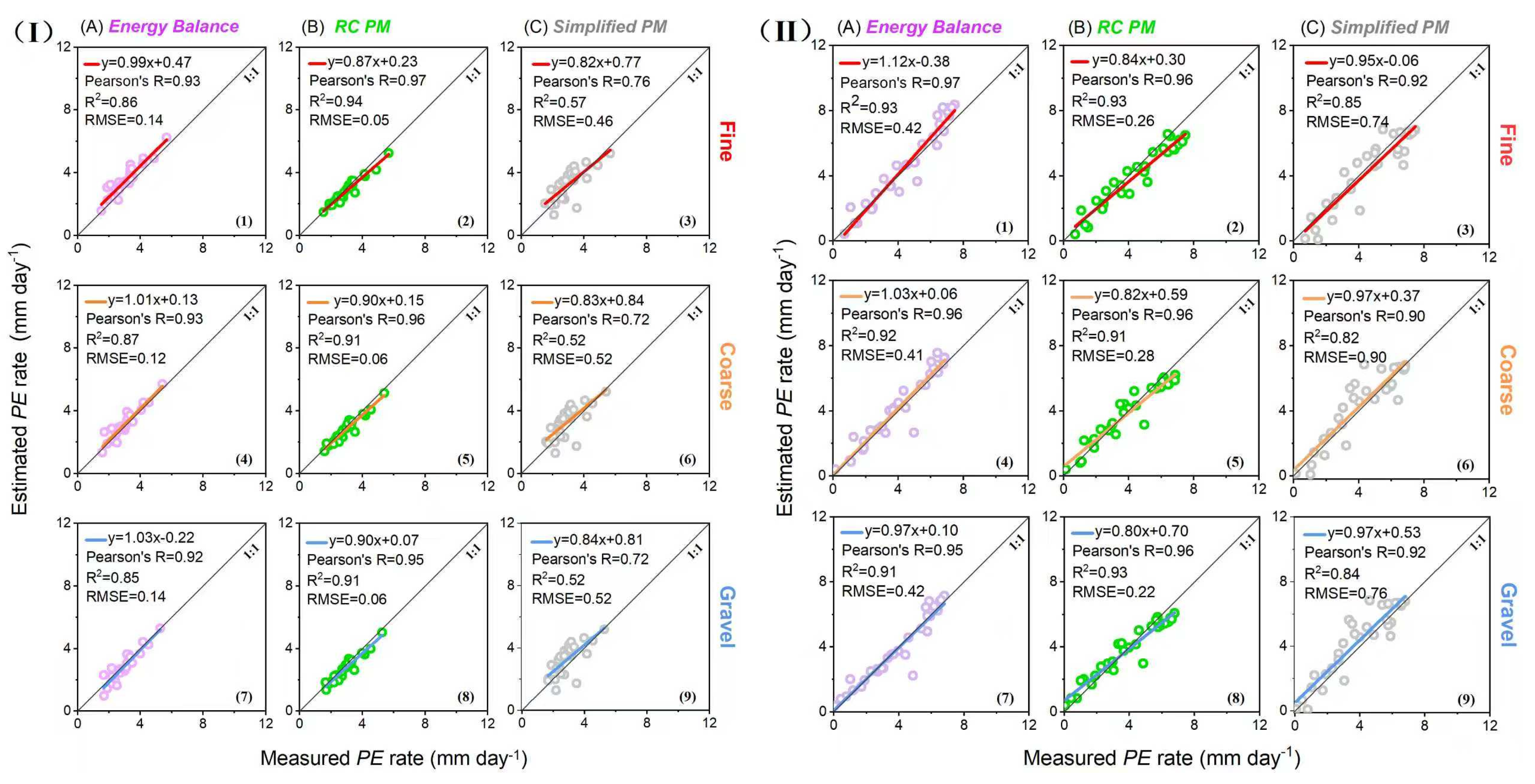
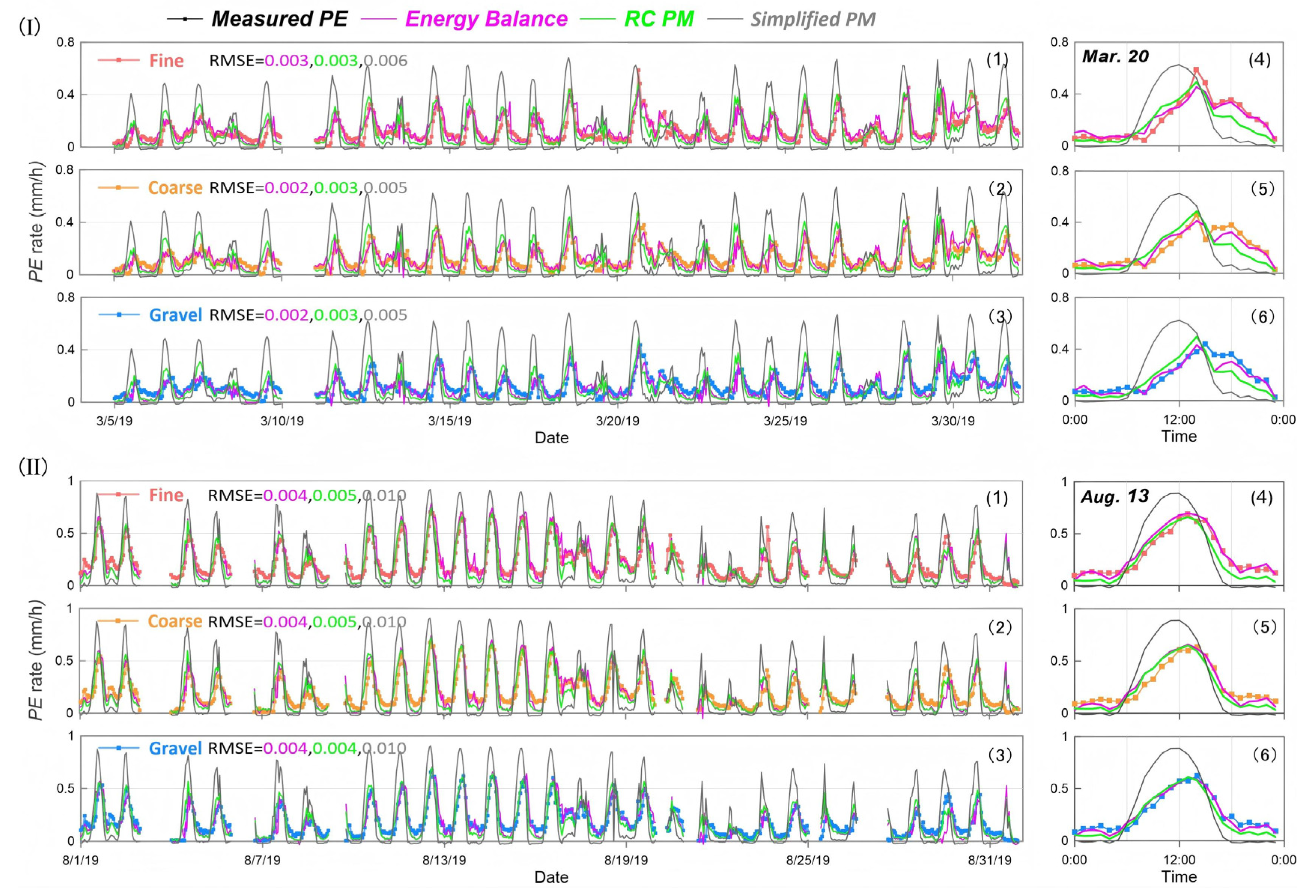
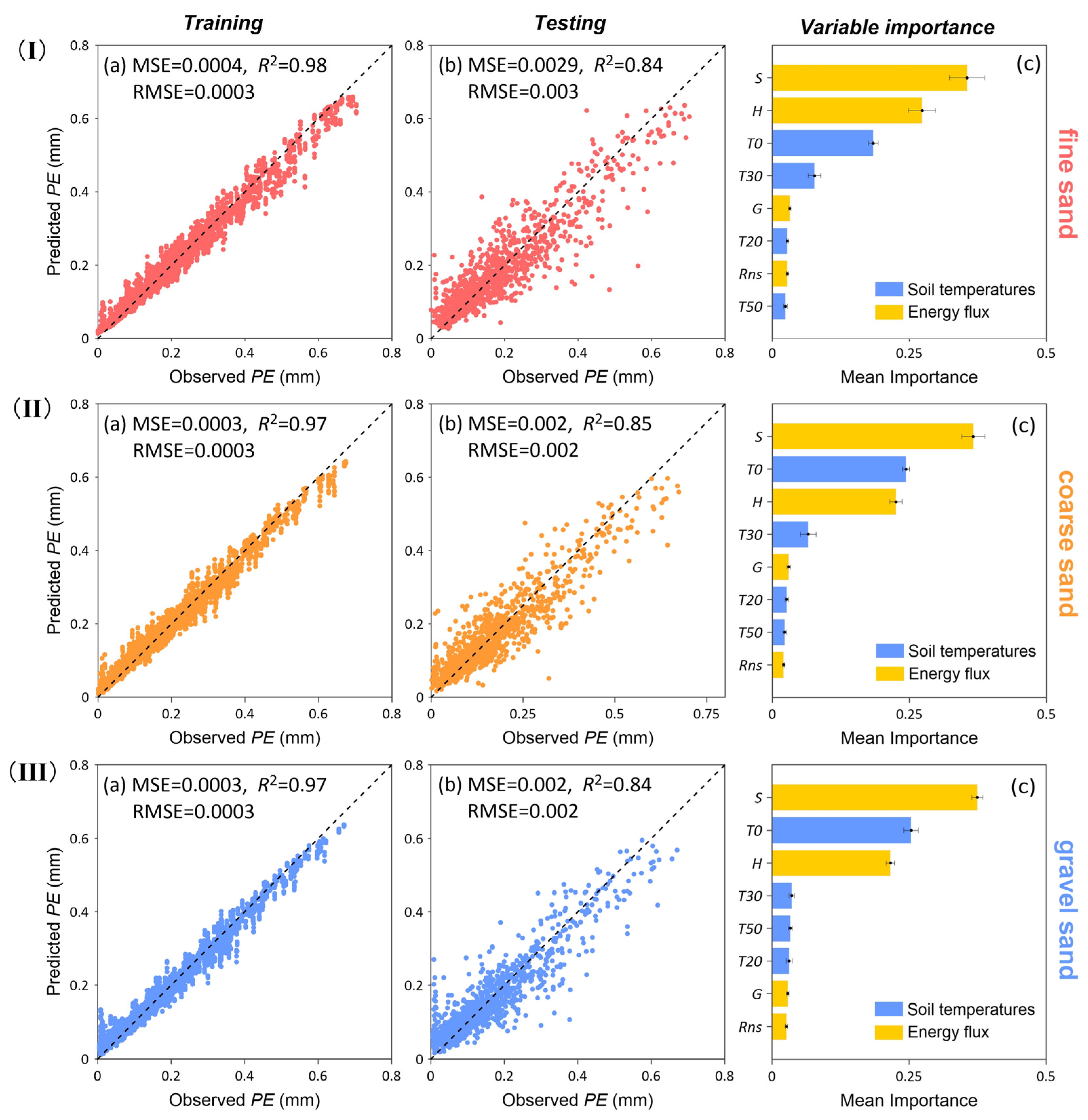
| Meteorological Elements | Instruments | Company | Installation Height (m) |
|---|---|---|---|
| precipitation | TE525 | Campbell Scientific Inc. Logan, UT, USA | 0.7m |
| air temperature and relative humidity | 083E-1–6 | Met One Instrument. Grants Pass, OR, USA | 1.5m |
| wind speed | RM Young Wind Monitor | Campbell Scientific Inc. Logan, UT, USA | 2m |
| radiations | CNR4 | Kipp&Zonen. Logan, UT, USA | 1.5m |
| data logger | CR-3000 | Campbell Scientific Inc. Logan, UT, USA | 1m |
| Methods | PEfine | PEcoarse | PEgravel | PEfine-PEcoarse | PEcoarse-PEgravel | |||||
|---|---|---|---|---|---|---|---|---|---|---|
| Mar | Aug | Mar | Aug | Mar | Aug | Mar | Aug | Mar | Aug | |
| Measurements | 79.80 | 137.59 | 76.66 | 121.21 | 75.86 | 115.92 | 3.14 | 16.38 | 0.79 | 5.29 |
| Energy balance | 91.34 | 143.23 | 80.50 | 126.62 | 72.63 | 115.14 | 10.84 | 16.76 | 7.87 | 11.34 |
| Radiatively coupled PM | 75.38 | 123.92 | 72.77 | 117.58 | 70.77 | 113.59 | 2.61 | 6.65 | 1.99 | 3.87 |
| Simplified PM | 85.75 | 128.48 | 85.66 | 128.34 | 85.48 | 128.05 | 0.09 | 0.14 | 0.18 | 0.28 |
Disclaimer/Publisher’s Note: The statements, opinions and data contained in all publications are solely those of the individual author(s) and contributor(s) and not of MDPI and/or the editor(s). MDPI and/or the editor(s) disclaim responsibility for any injury to people or property resulting from any ideas, methods, instructions or products referred to in the content. |
© 2025 by the authors. Licensee MDPI, Basel, Switzerland. This article is an open access article distributed under the terms and conditions of the Creative Commons Attribution (CC BY) license (https://creativecommons.org/licenses/by/4.0/).
Share and Cite
Li, W.; Li, Z.; Cheng, J.; Wang, Y.; Wang, F.; Wang, J.; Wang, W. Influence of Soil Temperature on Potential Evaporation over Saturated Surfaces—In Situ Lysimeter Study. Agronomy 2025, 15, 2381. https://doi.org/10.3390/agronomy15102381
Li W, Li Z, Cheng J, Wang Y, Wang F, Wang J, Wang W. Influence of Soil Temperature on Potential Evaporation over Saturated Surfaces—In Situ Lysimeter Study. Agronomy. 2025; 15(10):2381. https://doi.org/10.3390/agronomy15102381
Chicago/Turabian StyleLi, Wanxin, Zhi Li, Jinyue Cheng, Yi Wang, Fan Wang, Jiawei Wang, and Wenke Wang. 2025. "Influence of Soil Temperature on Potential Evaporation over Saturated Surfaces—In Situ Lysimeter Study" Agronomy 15, no. 10: 2381. https://doi.org/10.3390/agronomy15102381
APA StyleLi, W., Li, Z., Cheng, J., Wang, Y., Wang, F., Wang, J., & Wang, W. (2025). Influence of Soil Temperature on Potential Evaporation over Saturated Surfaces—In Situ Lysimeter Study. Agronomy, 15(10), 2381. https://doi.org/10.3390/agronomy15102381









